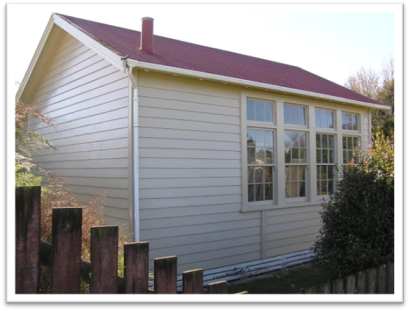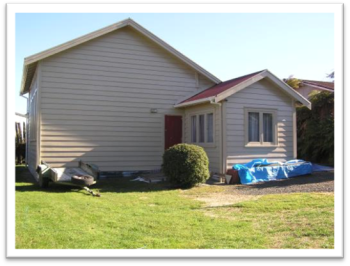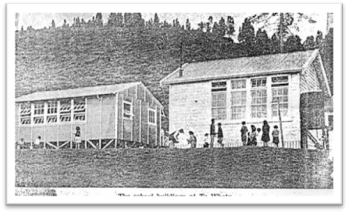HH-36: Te Whetu School / Tokoroa Red Cross Hall

Date of Photograph: 29/07/2008
Location and Zoning Information | |
Address |
4 Paraonui Road, Tokoroa (adjacent to the reserve (lot #2) and accessed by the driveway for 6 Paraonui Road |
Current Owner |
D & A.P. Duggan |
Legal Description |
Lot 1 DP 373480 |
Zoning |
General Residential Zone |
Valuation Number |
0547200301 |
Google Maps Link |
|
Architecture | |
Date of Construction |
1925 |
Materials |
Exterior - wood with a corrugated iron roof. Interior- wood and gib (note: recently relined with gib board) |
Architecture/Engineer/Builder |
Building Type: Linear Design Classroom (Kellaway 1981) This type of classroom design was constructed by the Auckland Education Board from about 1920 through 1928. The ‘Linear Design Classroom’ has no windows on the gable ends nor the type of roof ventilation typical in previous school designs. The ‘Linear Design’ featured windows on the north facing wall to take advantage of natural light with transoms windows for ventilation. Te Whetu School is L-shaped in plan with a gabled roof and is clad in weatherboard. The structure was designed for a small school population and features a single classroom. The main entry is formed by a small recessed porch located between the toilet/ washroom and the teacher’s room. The main entry opens into a short hall that provides access to the teachers room, toilet/ washroom, and classroom. A second exterior access door is located at the gable end of the classroom. The main classroom roof extends over the toilet/ washroom and teachers room. The corrugated iron roof still features a stove pipe. The stove would have been the main source of heat for the school. Photographs of the school on site at Te Whetu suggest that the exterior of the building has been altered very little over the years. |
Condition |
Excellent. Recently repainted and being converted into a self contained residence (June 2007). |
Original Site Recommendation |
De Lisle, Leslie 2006 pers communication to Alexy Simmons about the Red Cross Hall in Tokoroa. Kellaway, J W 1981 Education 150 from Schoolhouse to Classpace in the Waikato- Bay of Plenty. On file Hamilton Public Library. Putaruru Press, 20 October 1961 Scherer, Vicki 1992 Putāruru Home of the Owl. Published by South Waikato District Council. Vennell, CW and Mona Gordon, MEW FitzGerald, TE McMillan, G Gilmore Griffiths 1951 Centennial History of Matamata Plains. Matamata County Council. |
Current Use |
Residential |
Statement of Significance | |
1. Historical aspect - Te Whetu school represents the economic influence the timber industry had on Te Whetu. Community growth resulted in the establishment of institutions like schools, public halls, and churches. The structure continued to function as a community building when it was relocated to Tokoroa in the 1960s and acquired a history in Tokoroa as the Red Cross Hall. Its public use has only recently changed. The building is a good example of the ‘Linear Design Classroom’ style used by the Education Board in the 1920s. A feature of the design is the use of natural light and ventilation. This element of the building has not been modified over the years and remains a dominant feature of the building. Integrity- The exterior architectural integrity of the building is good. (The structures exterior profile and form has changed little based on comparison with historic photographs). The building still features the original cladding, fenestration and the original classroom/ playground access door. The main entry door is a four panelled style that was used in school buildings from an earlier period (i.e. this style of door is shown in school drawings and contract plans for circa 1880 to 1913). The main entry door may have been inserted recently or been a replacement door inserted during the buildings use as a school. The exterior design continues to communicate the structures original design and use as a school. The historical integrity of the building as a school has been affected by relocation and use. The building was relocated from Te Whetu to Tokoroa in 1965 for use as a Red Cross Hall. The new public use in 1965 reflects the common practice of reuse and relocation of community buildings for public purposes. Since 1965 the building has accrued approximately forty years of history on its current site as a public hall. The ‘Linear Design Classroom’ retained its interior and exterior integrity during its use as a Red Cross Hall. This included retention of a blackboard on one wall. Recently the interior architectural integrity of the building and use of the building as a public facility has changed. The building has been relined and is currently being converted into a residence. Although the interior of the building has been altered substantially the exterior elements of the building remain and still communicate its original use as a school and later use as a public hall. Education- The building could be included as an item on a heritage trail of Tokoroa with directions provided for viewing the structure from the reserve. Te Whetu School/ Tokoroa Red Cross Hall/ residence still retains its original external form. It could be interpreted as it was built and originally used, i.e. Te Whetu School. It could also be interpreted as it was recycled and reused as Tokoroa’s Red Cross Hall for approximately forty years. An interpretation sign could be erect on the reserve opposite the structure that contains historic photographs and describes the structures history. Alterations could also be made to the reserve fence to make the building more visible. (note: this could include lowering a section of the fence and inserting plexi-glass panels). District Plan RulesDemolition- DIS. Refer to GRZ-R3 Protection focus- Avoid demolition. If demolition is the only option document the structure. Relocation- DIS. Refer to GRZ-R3. Protection focus- Mitigate the effects by 1) Consulting with the local community, and/ or consulting with Iwi or special interest groups, 2) Relocating to a similar setting, 3) Documenting (HBD). Alterations necessary for the primary purpose of improving structural performance, fire safety or physical access – CON -Refer to HH-R2. Other Additions/Alterations - DIS. Refer to GRZ-R3. Protection focus- form, scale, exterior elements that indicate previous use as a 1925 school- “Linear Design Classroom.” The design form and scale of the building is small and indicative of its original use and should not be compromised by additions. The most significant elevation is the elevation parallel to the reserve. This elevation should not be modified. The most significant exterior design element is the fenestration on the classroom wall, ie the four double hung wooden sash windows with transoms. The windows should not be compromised by removal or external alterations or replacement. If double pane glass is desired this should consist of an internal layer of glass. If repair is required the existing fenestration should be matched. The building is clad in weatherboard. If repairs are required this element should be retained by repair and replacement with boards of a similar profile. The roof is clad in corrugated iron. The roofing profile should be retained by repair/ replacement with corrugated iron of the same profile. No dormers should be inserted into the roof line. A flush sky light could be inserted on the rear roof of the building to provide more natural light and ventilation. The door at the end of the classroom is an original door and should be retained. If repair is required the door should be replicated or replaced with one of the same style. Re-use/ Change of Use- This has already occurred. Internal Changes- These have already occurred. | |
History | |
The former Te Whetu School/Tokoroa Red Cross Hall was the second school in Te Whetu. The school was in use for approximately 40 years. Te Whetu had a series of schools that reflected the growth and eventual decline of the community. Over the years a total of 889 pupils passed through the Te Whetu school, the majority of these students would have spent many of their school years in the ‘Linear Design Classroom’. When the school had its school jubilee in 1961, it had a roll of 38 pupils. The first school at Te Whetu was opened on 4 September, 1911 to its first intake of students. Establishment of the school was associated with timber harvest in the region and the growth of Te Whetu. Bartholomew Land and Timber Company commenced operation at Te Whetu in 1910. Te Whetu grew from a small Maori settlement to a village of 150 people with its own store, town hall, and school. The first school building was probably provided by the local community or the mill. The school was described as being “a very plain, unpainted building on a site close to the mill” (Putāruru Press 20 October 1961). The 1911 school was probably near the South Taranaki Timber Company mill and not the Bartholomew Land and Timber Company (based on references made in a newspaper article about the school reunion). In approximately 1925 the pine forest was planted at Te Whetu. At that time the school was relocated to a site away from the mill. Whether the old building was relocated is not known. A new school was constructed at Te Whetu in 1925 by the Auckland Education Board. This school is the building located on Paraonui Road adjacent to the reserve (#4 Paraonui Road). The school was a ‘Linear Design Classroom’. The ‘Linear Design’ featured windows on the north wall instead of the gable end to make use of natural light (Kellaway 1981). The design focus was on increasing student health through classrooms that featured sunlight and natural ventilation. Ventilation was through the transom above the double hung sash windows. The classroom layout featured blackboards on the gable ends. Until recently Te Whetu School still had its blackboard. (Red Cross member Leslie De Lisle pers comm. 2006: “the building still contains the original blackboard and is a large hall like structure”). Photographs taken of the Te Whetu School show two school buildings of different designs adjacent to the ‘Linear Design Classroom’ (see attached photographs under additional photographs). These buildings appear to date from different periods of time. The older of the two structures had a low gable roof with vertical battens on the exterior walls. This building may have been erected as a temporary classroom in the late 1940s or early 1950s and is similar to the unit classroom, AK1 style, (Kellaway 1981:200). If the classroom was the AK1 style it was probably clad in asbestos cement panels and considered a temporary structure (see attached photographs and Kellaway 1981:200-203). By the 1960s this structure was replaced by an SA1 classroom (see photograph). The SA1 classroom was clad in weather board and featured a shed roof that shaded the front casement windows. This style of building was used from approximately 1953 through the following ten years. The SA1 plan size was modified by the Education Board over the years. The later designs had an extended front roof that formed a narrow veranda. The veranda was used as an external corridor between classrooms. In the 1960s the two buildings that comprised Te Whetu School became redundant, ie the ‘Linear Design Classroom’ and the SA1 classroom. Both buildings were relocated. (Newspaper comments suggest the SA1 classroom was shifted to another school). The ‘Linear Design Classroom’ was relocated in 1965 by the Tokoroa Red Cross and placed on the site adjacent to the reserve on Paraonui Street. Recently the Tokoroa Red Cross ceased using the building due to a decline in membership. The building has now been converted into a residence. The classroom has been lined with gib and a partial mezzanine floor has been inserted in one corner. The mezzanine floor has been designed as a sleeping loft and is located in the northwest corner of the classroom. The ‘sleeping loft’ corner of the classroom has no historic openings (doors or windows). The loft is set back from the main classroom windows and was not apparent from the exterior during the day. | |
Additional Photographs

